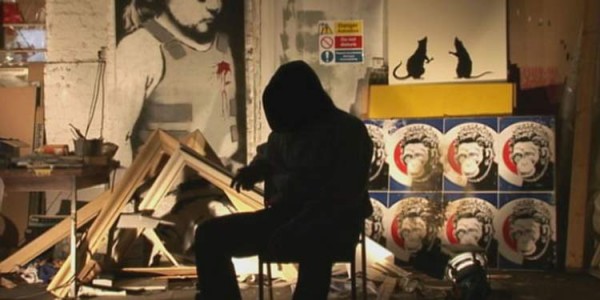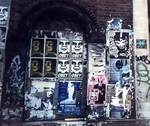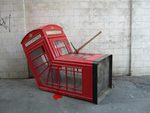 Wild style turns ironic, manic, and political
Wild style turns ironic, manic, and politicalTwo things are absolutely clear about
Exit Through the Gift Shop: that its origins are somewhat ambiguous, and that it is one of the best documentaries of the year, even if it's a "pseudo-" one. The film's trajectory is to seem a film made by Thierry Guetta, a transplanted Frenchman and successful L.A. vintage clothing dealer turned compulsive videographer -- until that impression is steadily undermined in the film's second half when mysterious art superstar Banksy takes over.
After shooting everything, apparently out of a mental deformation due to losing his mother suddenly at the age of eleven and gaining a sense of the fleeting nature of existence, Thierry finds a subject, Street Art. A relative of his is a street artist in France called Invader who does little paste-on tile abstractions he attaches to buildings. Thierry soon latches onto an energetic street artist in L.A. called Shepard Fairey (later famous for his Barack Obama Hope poster) and becomes his assistant and friend. Before long he’s videoing many LA artists who use stencils, Kinko Copy blowups, painting, spray cans, and objects and risk arrest to create art temporarily in highly visible (and often dangerous-to-reach) public spaces. They welcome Thierry’s filming because their art is fugitive.
 Shepard Fairey "Andre the Giant" "Obey" images
Shepard Fairey "Andre the Giant" "Obey" imagesWe also see Thierry talking about his life and his reckless new career, for which he leaves his wife and kids for long stretches. And if we didn't know already, we learn about the legendary and notoriously invisible British street artist Banksy, whose projects are seen all over the world, while he is not. These include provocative paintings on the notorious "Apartheid" wall Israel has built to separate off the Palestinians. Observing and filming Banksy was Thierry's dream. He was the greatest and also the most inaccessible of his breed.
As the film tells it, Banksy came to L.A. one day and, through Shepard Fairey, contacted Thierry, to get logistic support and find the best spaces to paint on.
Now we begin to see and hear Banksy telling the story. Only he is hidden under a hoodie and his voice is disguised. (Many of the other artists or their helpers have been digitally made anonymous too.)
Banksy tells (and shows) us that, first, Thierry hadn't actually edited or even looked at all the reams of videos he'd made (which we see rooms full of boxes of), and, second, when he, Thierry, finally put together a "film" editing together videos of street art and its creation, the result (which we glimpse) was meaningless visual gibberish. "So I had to take over," Banksy says.
Then follows the story of how Thierry Guetta becomes a street artist himself, known as Mr. Brainwash (or MBW). After a short career of putting up Warholian images on the usual dangerously high-perched walls, very quickly Guetta jumps into the project of mounting his own giant art show, much the way Banksy himself did, in a rented L.A. warehouse. Who did this work, how it got such immense publicity (initially via
LA Weekly), and how much Thierry's filming all along was really his, or who edited it, becomes increasingly cloudy. For a while it comes to seem possible Thierry's career as an artist is a hoax of Banksy's to show the gullibility of the public and the way publicity generates art and attaches value to it that it would not otherwise have.
And the way once-dignified art museums have become greedy producers of blockbuster shows that all must "exit through the gift shop" -- to attract more visitors and raise profits. But Banksy may rather have created a monster by encouraging Thierry to put down his camera and turn to art-making. MBW's giddy productions are just a mishmash of the styles of every artist Thierry eagerly but mindlessly documented. "Mr. Brainwash is a force of nature, he's a phenomenon. And I don't mean that in a good way," Banksy declared. The film is amusing, but the pill it delivers is bitter.
Not entirely, though. It also embodies a joyous, madcap enthusiasm for the excitement of art by Banksy and other street artists who take major intellectual risks as well as physical and legal ones. Thierry himself was held for four hours after he was caught filming Banksy’s inflated-doll Gitmo prisoner in a park at Disneyland, but managed to cover up the fact that he was in cahoots with Banksy on the piece by deleting his film while being questioned. So he says, anyway.
The street artists have gone beyond graffiti into art-making that's not only risky and barely legal, but increasingly complex and conceptual and may require teams of assistants and heavy equipment. Examples are the L.A. shows first of Banksy and then of Mr. Brainwiash AKA Theirry Guetta, like the paintings on the Israel wall or the traditional red London phone booth Banksy's people steal, take to a workshop, chop in half, and reshape into a sharp-angled object they later dump on a street corner.

It's a shame so much of Thierry's stuff in his show, entitled “Life Is Beautiful,” looks like inferior Warhol, or clichéd defacing of art chestnuts, like the Mona Lisa with an eye patch. Being a distinctive street artist has generally meant having one's own signature outlook, style, and imagery. Banksy has appeared more protean, but he is unique too, in being so ambitious, daring, and successful at hiding his identity.
There are two positive highs in the film: the high of Thierry’ passionate following of street art in LA, and the high of Thierry’s manic transformation into Mr. Brainwash. The rift between the two highs is the interruption when Banksy tells us Thierry’s films were just piled away in boxes and his effort to condense them into a film a complete failure. From then on all sense that this is a consistently made documentary dissolves. To some extent the fun of the film spoils some of the real potential documentary value here, because the street artists filmed at the beginning really are interesting in themselves and worthy of more thorough coverage, and Banksy is an artist/outlaw of international importance worthy of a straightforward film biography. However, the hoax-like, foggy nature of this film is appropriate, because one of the main topics of street art is how public imagery is manipulated and falsified.
Exit Through the Gift Shop is in the tradition of art about forgery that is itself half-forged.
________________
This was a sensation at Sundance and showed out of competition at the Berlinale, though slow to be picked up. Opened in US theaters April 10, unrolling slowly since.
Exit Through the Gift Shop, 87 mins., debuted at Sundance 24 Jan. 2010; also Berlinale 14 Feb.
Metacritic rating: 85%.
_________
Related art info from Cool Hunting: "Mr. Brainwash's massive exhibition of pop-graffitit portraits hits NYC,"
here.




